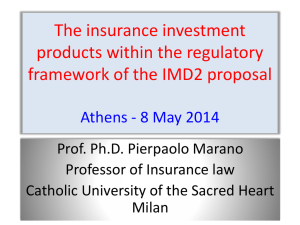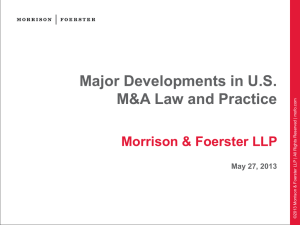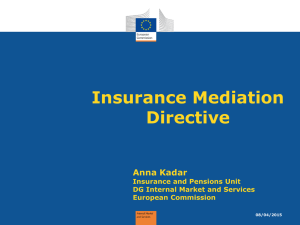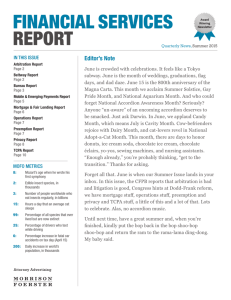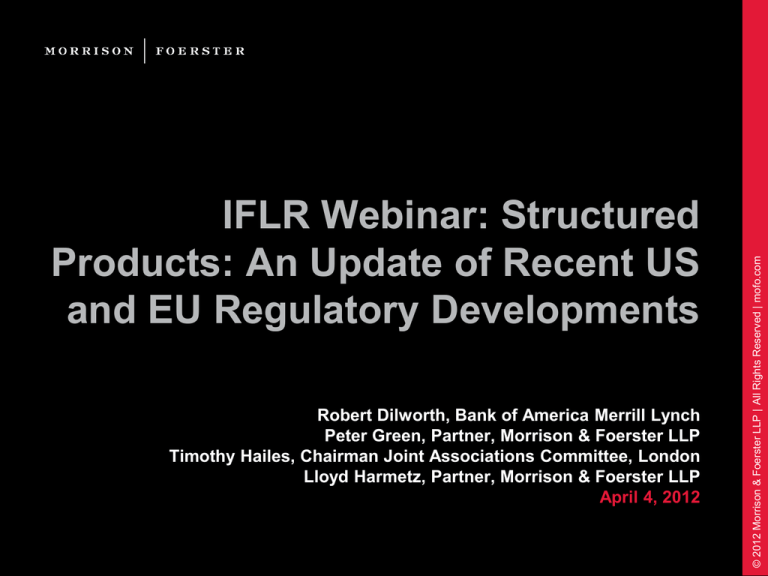
Robert Dilworth, Bank of America Merrill Lynch
Peter Green, Partner, Morrison & Foerster LLP
Timothy Hailes, Chairman Joint Associations Committee, London
Lloyd Harmetz, Partner, Morrison & Foerster LLP
April 4, 2012
© 2012 Morrison & Foerster LLP | All Rights Reserved | mofo.com
IFLR Webinar: Structured
Products: An Update of Recent US
and EU Regulatory Developments
FINRA: 2012 Regulatory and Examination
Priorities Letter (Jan 2012)
Continued Focus on Structured Products
Summarizes the Themes of Regulatory Notice 12-03 (discussed
below)
Principal concerns include:
Yield chasing.
Liquidity.
Cash flow characteristics – are they in line with investor expectations?
Transparency of cash flows.
Pricing of structured products in the secondary market.
Conflicts of interest in the sale and marketing of complex products.
This is MoFo.
2
FINRA Regulatory Notice 12-03, January 2012
Heightened Supervision of Complex Products
What is 12-03?
Guidance to firms about supervision.
An attempt to identify characteristics that render a product “complex” – largely
focused on structured products.
This is MoFo.
3
FINRA Regulatory Notice 12-03, January 2012 Background
The notice continues to address many of the themes of prior
regulatory action.
Notice to Members 03-71 (Nov. 2003): Selling Non-Conventional Investments
Notice to Members 05-26 (April 2005): Reviewing New Products
Notice to Members 05-59 (Sept. 2005): Sales of Structured Products
Regulatory Notice 09-31 (June 2009): Leveraged and Inverse Exchange-Traded
Funds
Regulatory Notice 09-73 (Dec. 2009): Principal-Protected Notes
Regulatory Notice 10-09 (Feb. 2010): Reverse Exchangeable Securities
Regulatory Notice 10-51 (Oct. 2010): Commodity Futures
This is MoFo.
4
FINRA Regulatory Notice 12-03, January 2012 Background
12-03 Focuses on Activities of Other Regulators
SEC (U.S.)
European and Asian Regulators
This is MoFo.
5
FINRA Regulatory Notice 12-03, January 2012
What Is Complex?
12-03 doesn’t attempt to definitively answer that question.
“Any product with multiple features that affect its investment returns
differently under various scenarios is potentially complex. This is
particularly true if it would be unreasonable to expect an average
retail investor to discern the existence of these features and to
understand the basic manner in which these features interact to
produce an investment return.”
This is MoFo.
6
FINRA Regulatory Notice 12-03, January 2012
Examples of Complex Products
Products that include an embedded derivative component “that may
be difficult to understand”:
Reference asset, the performance of which is not readily available to investors.
(the CMS rate)
Notes that provide for different stated returns throughout the lifetime of the product.
(Steepener notes with a high teaser rate)
Range accrual notes.
Notes where loss is possible, but no participation in gains. (RevCons)
Notes with a “knock in” or “knock out” feature, where a change in the performance
of the reference asset can have a disproportionate impact on the repayment of
capital or on the payment of return.
Products with contingencies in gains or losses, particularly those that depend upon
multiple mechanisms, such a range accrual notes with two or more reference
assets.
This is MoFo.
7
FINRA Regulatory Notice 12-03, January 2012
Examples of Complex Products (cont.)
Notes with “worst-of” features.
Investments tied to the performance of markets that may not be well understood by
many investors, such as volatility.
Products with principal protection that is conditional or partial, or that can be
withdrawn under certain circumstances.
Product structures that can lead to performance that is significantly different from
what an investor may expect, such as products with leveraged returns that are
reset daily (e.g., leveraged ETFs)
Products with complicated limits or formulas for the calculation of investor gains.
This is MoFo.
8
FINRA Regulatory Notice 12-03, January 2012
Approval Requirements for Complex Products
Firm must perform a “reasonable basis” suitability determination: a
transaction or investment strategy is suitable for at least some
investors.
To do so, the firm must perform reasonable diligence to understand
the nature of the transaction, as well as the potential risks and
rewards.
This understanding should be informed by an analysis of likely
product performance in a wide range of normal and extreme market
actions. The lack of such an understanding when making the
recommendation could violate the suitability rule.
Firms should have formal written procedures to ensure that their
registered representatives do not recommend a complex product to a
retail investor before it has been thoroughly vetted. The procedures
should ensure that the right questions are answered before a
complex product is recommended to retail investors.
This is MoFo.
9
FINRA Regulatory Notice 12-03, January 2012
Questions for the New Product
For whom is this product intended? Limited or general retail
distribution, and, if limited, how will it be controlled?
To whom should this product not be offered?
What is the investment objective and is that objective reasonable in
relation to the product’s characteristics? How does the product add
to or improve the firm’s current offerings? Can less complex products
achieve the same objectives?
What assumptions underlie the product, and how sound are they?
How is the product expected to perform in a wide variety of market or
economic scenarios? What market or performance factors determine
the investor’s return? Under what scenarios would principal
protection, enhanced yield, or other benefits not occur?
What are the risks for investors? If the product was designed mainly
to generate yield, does the yield justify the risks?
This is MoFo.
10
FINRA Regulatory Notice 12-03, January 2012
Questions for the New Product (cont.)
How will the firm and registered representatives be compensated?
Will the offering of the product create any conflicts of interest
between the customer and any part of the firm? If so, how will those
conflicts be addressed?
Are there novel legal, tax, market, investment or credit risks?
Does the product’s complexity impair understanding and
transparency of the product?
How does this complexity affect suitability considerations or the
training requirements for the product?
How liquid is the product?
This is MoFo.
11
FINRA Regulatory Notice 12-03, January 2012
Post-Approval Review
Firm should periodically reassess complex products a firm offers to
determine whether their performance and risk profile remain
consistent with the manner in which the firm is selling them.
Firms also should consider developing procedures to monitor how
the products performed after the firm approved them.
Firms also should conduct periodic reviews to ensure that only
associated persons who are authorized to recommend complex
products to retail customers are doing so.
This is MoFo.
12
FINRA Regulatory Notice 12-03, January 2012
Training
Registered representatives who recommend complex products must
understand their features and risks.
Registered representatives who recommend structured products should
possess a “sophisticated understanding” of the payoff structure and risks.
The registered representative should be able to develop a payoff diagram of
a structured product to facilitate the analysis of its embedded features and
recognize that such a product typically consists of a bond and derivative
parts.
The registered representative also should understand such features as the
characteristics of the reference asset, including its historic performance and
volatility and its correlation with specific asset classes, any interrelationship
between multiple reference assets, the likelihood that the complex product
may be called, and the extent and limitations of any principal protection.
The registered representative should be adequately trained to understand
not only the manner in which a complex product is expected to perform in
normal market conditions, but the risks associated with the product.
This is MoFo.
13
FINRA Regulatory Notice 12-03, January 2012
Consideration of a Customer’s Financial Sophistication
12-03 encourages firms to adopt the approach mandated for options
trading accounts: would require that a registered representative have
“a reasonable basis for believing, at the time of making the
recommendation, that the customer has such knowledge and
experience in financial matters that he may reasonably be expected
to be capable of evaluating the risks of the recommended
transaction, and is financially able to bear the risks of the
recommended position in the” complex product.
Firms also should consider prohibiting their sales force from
recommending the purchase of some complex products to retail
investors whose accounts have not been approved for options
trading, particularly the recommendation of complex products with
embedded options or derivatives.
Similar text to 05-59.
This is MoFo.
14
FINRA Regulatory Notice 12-03, January 2012
Consideration of a Customer’s Financial Sophistication (cont.)
Firms that permit the recommendation of complex products to retail
investors whose accounts have not been approved for options
trading should:
Develop other comparable procedures designed to ensure that their
sales force does not solicit retail customers for whom complex
products are unsuitable
Be prepared to demonstrate the basis for allowing their sales force to
recommend complex products to retail investors with accounts not
approved for options trading.
Approving an account for the purchase of complex products is not a
substitute for a thorough suitability analysis.
This is MoFo.
15
FINRA Regulatory Notice 12-03, January 2012
Discussions with the Customer
The registered representative who intends to recommend a complex
product should discuss with the customer:
the features of the product
how it is expected to perform under different market conditions
the risks and the possible benefits, the costs of the product
the scenarios in which the product may perform poorly.
The registered representative should consider whether, after this
discussion, the retail customer seems to understand the basic
features of the product.
This is MoFo.
16
FINRA Regulatory Notice 12-03, January 2012
Consideration of Whether Less Complex or Costly Products
Could Achieve the Same Objectives for the Customer
Registered representatives should consider whether less complex or costly
products could achieve the same objectives for their customers.
For example, registered representatives should compare a structured product with
embedded options to the same strategy through multiple financial instruments on
the open market, even with any possible advantages of purchasing a single
product.
This is MoFo.
17
FINRA: December 2011 Consent re
Reverse Convertible Notes
Fined Wells Fargo $2 million, plus restitution.
Unsuitable sales by a registered representative.
Consent agreement continues many of FINRA’s prior themes.
Relevant activities took place between 2006 and 2009.
This is MoFo.
18
FINRA: December 2011 Consent re
Reverse Convertible Notes (cont.)
Adequate Written Supervisory Procedures and an Effective
Supervisory System
Close attention should be paid to customer profiles and investment history.
Transactions should be approved upon adequate inquiry into the suitability of the
purchases and concentrations in the accounts.
Firms should provide supervisors with reports that demonstrate customer
investment concentrations to assist in suitability identification.
Although there was a required training program, there was no system in place to
ensure compliance; many registered representatives placed trades without
completing the training program.
This is MoFo.
19
FINRA: December 2011 Consent re
Reverse Convertible Notes (cont.)
A Firm’s Sales Representatives Must Be Adequately Supervised
Broker dealer did not investigate the suitability of the reverse convertibles being
sold to elderly customers.
To facilitate these transactions, the broker changed the investment objectives of
some customers – red flags that went without investigation, despite compliance
reports showing large concentrations of reverse convertibles.
This is MoFo.
20
EU Developments - Themes
Harmonization of provisions across different products / level playing
field
Move towards single market / single rule book
One size fits all?
More intervention and through the cycle intervention
Increased regulatory capture
More centralisation (more legislation in the form of EU regulation)
Greater role for ESMA
Focus on enforcement and supervision
This is MoFo.
21
EU Developments – Overview of Legislative
Developments
Packaged retail investment products (PRIPs)
Markets in Financial Instruments Directive (MiFID) and MiFID II draft
legislation
Prospectus Directive amendments
Huge raft of other relevant EU and national legislation including:
Alternative Fund Managers Directive (AIFMD)
UCITS IV / UCITS V
European Market Infrastructure Regulation (EMIR)
Recast Market Abuse Directive / Regulation
CRD IV
Retail Distribution Review (UK)
This is MoFo.
22
PRIPs - Background
Proposal is a more consistent approach for regulation of packaged
retail investment products irrespective of how packaged
It is envisaged the PRIPs legislation will cover at least :
Investment funds
Structured securities
Certain life insurance policies
Structured deposits
Process began with EU Commission Call for Evidence in October
2007
EU Commission Consultation on PRIPs – 26 November 2010
EU Commission draft legislation on MiFID II / MiFIR – October 2011
Draft PRIPs legislation awaited
This is MoFo.
23
Proposed Definition of PRIPs
“A product where the amount payable to the investor is exposed to
fluctuations in the market value of assets or payouts from assets,
through a combination or wrapping of those assets, or other
mechanisms than a direct holding”
Consideration of “white list” of PRIPs
Proposed definition does not embed retail element but it is intended
that disclosure and selling rules should only apply to sales to retail
investors
This is MoFo.
24
PRIPs – Disclosure Requirements
EU Commission proposes development of new disclosure framework
applicable to PRIPs generally – “Key investor information disclosure”
UCITS “KII” regarded as benchmark
Objective is harmonisation and standardisation of key disclosures:
Product disclosures and any associated marketing communications should be fair,
clear and not misleading
Information necessary to allow investor to take an informed investment decision
Allowing for comparison between products
Some tailoring permitted
Issue as to whether KIID should be a document separate from any
other prospectus or background document
Interaction of PD summary section and KIID not yet clear
This is MoFo.
25
PRIPs – Disclosure Requirements –
Issues for further consideration
Risk considerations – inclusion of simple risk indicator?
Costs – aim is to enable easy comparison between different products
Approach in relation to information on performance
Information to enable comparability between guarantees or capital
protection for PRIPs
Responsibility for KIID preparation – likely to be product
manufacturer in most cases
Obligation to update KIID?
Development of KIID template:
Template produced for UCITS KIID is very prescriptive
JAC submissions and proforma template
This is MoFo.
26
PRIPs – Selling Practices
Key elements identified by the Commission are:
Conduct of business rules
Inducements
Conflicts of interest
MiFID regarded as benchmark
Now being dealt with as part of MiFID II legislative package
Insurance Mediation Directive to be recast to be consistent with
MiFID rules on selling practices
This is MoFo.
27
MiFID II - Background
MiFID came into force in November 2007
Review highlighted for some time
EU Consultation Paper published on 8 December 2010
Draft legislative proposals published in October 2011
Conduct of business and conflicts of interest rules to be extended to:
Advised and non-advised sales of structured deposits
Firms selling their own securities to clients even on a non-advised basis
Client classifications largely unchanged
Some exceptions regarding “complex” instruments
This is MoFo.
28
MiFID II - Investor Protection
Scope of MiFID broadened to include sales of / advice on structured
deposits, as well as firms dealing on own account by executing client
orders
Client classification largely unchanged – eligible counterparty,
professional client, retail client – except as to local authorities
Duties to determine suitability / appropriateness of product / service
largely unchanged
If providing investment advice, must state whether it is provided on
an independent basis and, for independent advice, firms must
assess “sufficiently large” number of instruments available on the
market
Firms providing investment advice / portfolio management will not be
permitted to receive fees / inducements from any third party
This is MoFo.
29
MiFID II - Investor Protection (cont.)
Exemption remains for sale of non-complex instruments on
execution only basis – structured UCITS will not be non-complex, nor
any instrument embedding a derivative or “structure which makes it
difficult to understand the risk involved”
Firms must provide clients with details of their “best execution” policy
in sufficient detail and in easily understandable form
Tied agents prohibited from handling client money and / or financial
instruments
This is MoFo.
30
MiFID II - Transparency
Existing MiFID pre and post trade transparency regime for equity
markets to be extended to all bonds and structured products which are
Admitted to trading on a regulated market or
Traded on an MTF / OTF in respect of which a prospectus is published
Organised Trading Facility (OTF) is a new MiFID II concept being “any
facility or system (other than a regulated market or MTF) operated by an
investment firm or market operator that brings together multiple buy and
sell orders in relation to financial instruments on an organised basis in
order to form a binding financial contract”
Transparency rules will apply to OTC derivatives entered into by a
systematic internaliser which are clearing eligible under EMIR and those
traded on a regulated market MTF or OTF
Transparency rules to be calibrated for different products / transactions
through use of waivers by competent authorities
This is MoFo.
31
MiFID II - Product Intervention
MiFID consultation paper set out EU Commission intention to
introduce power to ban certain investment services and activities
MiFIR provides that ESMA can take action to prohibit or restrict
marketing, distribution or sale of a financial activity or practice if:
Addressing a threat to investor protection OR
The orderly functioning and integrity of financial markets OR
The stability of all or part of the EU’s financial system AND
Existing regulatory obligations are not sufficient and the relevant competent
authorities have not taken appropriate action to deal with the threat
ESMA must take into account any detrimental effect on the efficiency
of markets that such action may have and the possibility of
regulatory arbitrage
This is MoFo.
32
MiFID II - Product Intervention (cont.)
Competent Authorities will also have power to restrict marketing or sale
of financial instruments in their member state on the same grounds as
ESMA
Action must be proportionate taking into account:
Nature of risks identified
Level of sophistication of investors or market participants
Likely effect of action on investors or market participants
Relevant authority must consult with other authorities likely to be
effected by such action
Action must not have a discriminatory effect on services or activities
provided from another member state
At least one month’s notice must be given and details must be published
on authority's website
ESMA must seek to coordinate such action taken by competent
authorities
This is MoFo.
33
Product Intervention – Individual Action by EU Member
States
During last 18 months a number of EU member states have taken or
consulted in relation to various product intervention measures which
impact on structured products including:
UK
Belgium
Denmark
France
Italy
This is MoFo.
34
UK – Product Intervention
January 2011 Discussion Paper
Previous approach of pre-contractual disclosure and “point of sale”
regulation
New proposed interventionist stance
“where resulting benefits to majority from not being mis-sold a product outweigh
costs to the minority who might benefit from being able to access it”
Features more likely to provoke FSA intervention – complexity,
cross-subsidy, conflicts of interest, layers of charging, teaser rates,
exit charges, product names implying safety / return, difficult to
assess performance risks.
Warning signals of possible consumer detriment if risks not managed
through product governance processes
This is MoFo.
35
UK – Product Intervention (cont.)
Additional intervention powers being considered by FSA:
Pre-approval / pre-notification of products
Banning products
Banning product features
Pricing interventions
Increased prudential requirements (incl. capital requirements)
Consumer warnings
“Wealth” warnings
Preventing non-advised sales
Limiting sales to certain classes of clients
Competence requirements for advisers
This is MoFo.
36
UK Retail Distribution Review
Covers retail investment products – packaged products and structured
investment products
As well as “any other designated investment which offers exposure to
underlying financial assets in a packaged form which modifies that
exposure when compared with a direct holding in the relevant asset”
Intended to cover same scope as PRIPS definition – structured
deposits?
New, higher standards for independent advice, including new status of
“independent” and “restricted” for advisers
For independent advice, firm must conduct “comprehensive and fair
analysis” of alternative instruments
New, higher standards of qualification for retail investment advisers
Adviser charging – abolition of commission for advised sales of
investment products (whether sold on independent / non-independent
basis)
This is MoFo.
37
FSA Structured Products Guidance
FSA Consultation in November 2011
Finalised Guidance Published in March 2012
Guidance to structured products providers on internal systems and
controls relating to development, design marketing and distribution of
structured products
Objective is to minimise risk of “poorly designed products” and misselling (or mis-buying) further down distribution chain
Eight main areas of guidance including:
Product approval process
Product development / design
Marketing and distribution
Information to distributors / consumers
Post-sale responsibilities
This is MoFo.
38
Proposed Amendments to Prospectus Directive
Prospectus Directive sets out framework for prospectuses for EU
securities offerings – amended in 2010
Further amendments recently proposed by EU Commission in a
delegated amending regulation including relating to format and
content of final terms and prospectus summaries and other matters
ESMA provided technical advice to EU Commission in October 2011
Provisions will impact on structured products transactions
This is MoFo.
39
Proposed Amendment to Prospectus Directive (cont.)
Base prospectus and any supplement need to be approved by relevant competent
authority but no approval needed for final terms
Market practices in relation to final terms vary
EU Commission proposes to limit and harmonize the approach to information that can
be included in final terms
Draft amending regulation has categorised items required to be included in securities
note by Prospectus Regulation as follows:
Category A – must be included in base prospectus – cannot be left in blank for insertion in final terms
Category B – general principles must be in base prospectus. Final terms can only include information
not known at time of approval of base prospectus
Category C – base prospectus may reserve a space for later insertion of information not known at the
time of approval of base prospectus
Certain “additional information” may be included but is linked to information set out in Annex XXI,
including :
• Examples of complex derivatives securities referred to in recital 18 of the Prospectus Regulation
• Additional provisions, not required by the relevant securities note, relating to the underlying
• Countries where the offer takes place on admission to trading is being sought
This is MoFo.
40
Proposed Amendment to Prospectus Directive (cont.)
Issues of particular relevance for structured products:
A statement setting out the type of underlying must be contained in the base
prospectus
For securities linked to an index composed by the issuer, the description shall not
be included in the final terms
General principles of the manner of redemption and settlement procedure of the
security should be in the base prospectus
Market adjustment and extraordinary events and consequential amendments
should be set out in full in the base prospectus
Final terms may not amend or replace any information contained in the base
prospectus
This is MoFo.
41
Proposed Amendment to Prospectus Directive (cont.)
Requirements for content and style of summary include:
Should contain key information as set out in Annex XXII of amending Regulation
Length should not exceed longer of 7% of Prospectus length or 15 pages
Should be short, simple, clear and easy for target investors to understand
No “boilerplate”
Risk factors should highlight key risks relating to issuer, its industry and securities
This is MoFo.
42
Proposed Amendment to Prospectus Directive (cont.)
Amending Regulation requires a summary of each individual issue to
be appended to final terms:
Should provide key information of summary of base prospectus combined with
relevant parts of final terms
Information of summary of base prospectus should be limited to that relevant to
individual issue
Information in final terms blank in base prospectus
No word count limit
Interaction with PRIPs initiative
Proportionate disclosure regime for right issues and SMEs
To enter into force on 1 July 2012
2nd part of ESMA final advice published on 1 March 2012 to be
subject of further amending Regulation
This is MoFo.
43

